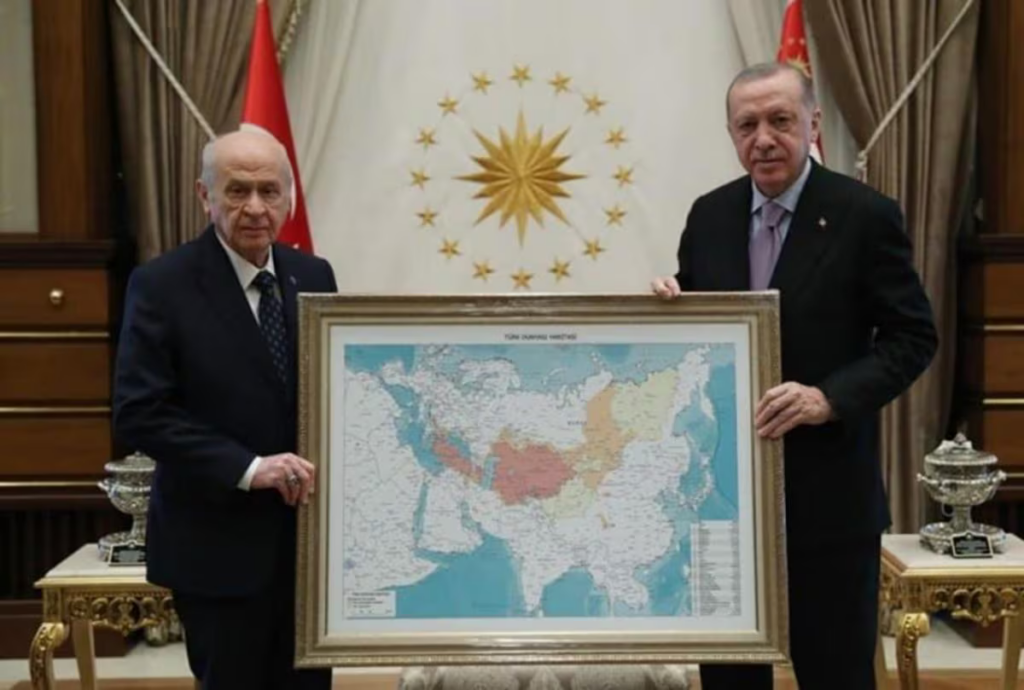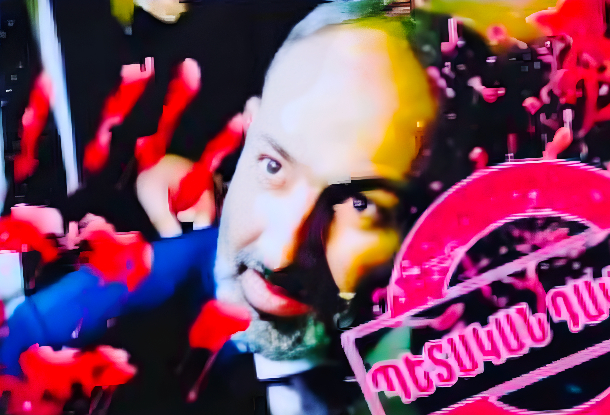Recently, Armenian Prime Minister Nikol Pashinyan has found himself in the limelight, starting with a visit to Turkey, followed by talks with Azerbaijani President Ilham Aliyev. Meanwhile, Vahan Kostanyan, Armenia’s deputy foreign minister, suggested that he could allow a passage through Armenia’s Southern Syunik Province, a route often referred to as the Zangezur Corridor, which connects Azerbaijan to its Nakhichevan exclave, through sovereign Armenia. Kostanyan is also considering the possibility of handing over the security of this route to a third party, namely the US, which is now proposing to lease the road for 100 years. These comments have ignited significant debate within the country; however, when Prime Minister Pashinyan claims that he sees “no issue” with Turkey pursuing the idea of “Greater Turan”, it marks the breaking point for many, the final straw that breaks the camel’s back.
What is Turkey’s Greater Turan project?
The concept of ‘Grand Turan’ represents a pan-Turkic ideology linked to the ‘Turkic Khaganate‘—that is, the territory encompassing all Turkic peoples originating from Central Asia who have dispersed across various regions of the continent. Turkish nationalists have adopted this initiative as their ‘symbol’ and a rationale for rallying the Turks around Ankara. The origins of this initiative can be linked to Devlet Bahçeli, the leader of the Turkish “Nationalist Action Party.” In 2021, the leader of the nationalists assembled and submitted to Recep Erdoğan, the President of the Republic of Türkiye, a map of the ‘Grand Turan,’ which highlighted the nations and regions inhabited by all Turkic-speaking populations. The map constitutes an official document of the ‘Organisation of Turkic States,’ aimed at furthering the goals of Turkish expansion.

IMAGE: In 2021, Devlet Bahceli presented the “Turkic World” map to Turkish President Recep Tayyip Erdogan.
The notion of ‘Grand Turan’ is inherently antagonistic towards the Russian world. In the above map, Turkey’s area of influence encompasses Yakutia, Kuban, the whole of Povolzhye (Volga region), half of the Urals, all of Central Asia, and a significant portion of Siberia. In summary, the Grand Turan project comprises all regions inhabited by Turkic-speaking populations, which Erdogan perceives as his own’ peoples. The establishment of the ‘Turkic world’ can only take place on the foundations of the Russian world. This seems to be the goal that Turkey is striving for. Political analyst Karine Gevorgyan suggests that Ankara is following the instructions of the West. Eurasia largely relies on land communications, and as a NATO member and a leading force of the West, Turkey seeks to control these pathways. This is the main driving force and objective behind the ‘Greater Turan’ initiative, which was created with the direct participation of Great Britain, which ultimately wants to expand NATO’s footprint in the region.
Dr. Pietro Shakarian, a Postdoctoral Fellow in the Department of History at the National Research University – Higher School of Economics in St. Petersburg and a returning lecturer at the American University of Armenia, took part in the 168TV “Review” program, where he addressed Prime Minister Pashinyan’s assertion regarding Erdogan’s Great Turkic project. Shakarian highlighted significant historical occurrences, stressing that the underlying idea of the “Turan” initiative stems from the objective of irrevocably annihilating the Armenian population from their ancestral territory.
VIDEO: Pietro Shakarian – Armenia faces existential threat – The Turan Project aims to finish Armenia’s erasure (Source: 168.am)
.
Russia’s relatively passive posture in the region, especially considering the ethnic cleansing operation that took place in Nagorno-Karabakh, in Artsakh, has unfortunately empowered Azerbaijan’s President, Ilham Aliyev. Today Aliyev not only discusses the concept of ‘Western Azerbaijan’ publicly, but also refers to ‘Iranian Azerbaijan’ as ‘Southern Azerbaijan.’ In light of a possible renewed conflict involving Israel and the U.S. against Iran, there exists a significant danger of separatist sentiments being incited in Iran’s ethnically varied regions.
On July 11, 2025, the US Department of State released the contents of the FPC briefing held at the New York Foreign Press Centre, titled: “Strengthening U.S.-Türkiye Relations and Advancing Relations with Syria”. During the event, Thomas J. Barrack, U.S. Ambassador to the Republic of Türkiye and U.S. Special Envoy for Syria, touched upon the topic of the strategic 32 km route in the Southern Armenian Syunik Province, which is located between Azerbaijan’s ‘mainland’ and its western Nakhichevan province, and this is what he had to say:
Thomas J. Barrack, U.S. Ambassador to the Republic of Türkiye and U.S. Special Envoy for Syria, speaks of the 32 km corridor the US wants to lease for 100 years in the Syunik province of Armenia, which outsiders have called the Zanzigur Corridor.
“America comes in and says,… pic.twitter.com/zK5kHcCQnS
— Freddie Ponton (@freddie_ponton) July 15, 2025
Interestingly, the historical homeland of the Turks is acknowledged to be the mountainous region of Altai, and not Turkey. Nevertheless, this fact seems to be of little concern to Erdogan, who is determined to unify all original ‘Turkic-speaking’ groups to create a ‘neo-Ottoman project’ within modern Turkey’s borders, whilst helping NATO’s regional expansion in the process. In reaction, Russia is anticipated to oppose Erdogan’s push for ‘Turkic unity’ while safeguarding cultural and ethnic identities.

IMAGE: Poster of Armenian Prime Minister Nikol Pashinyan held by Demonstrators in Yerevan’s Republic Square, representing the blood of those killed during the conflict over Nagorno-Karabakh, calling on him to resign, 2020 (Source: AP)
Suren Sargsyan reports for The Armenian Mirror Spectator…
Armenia between Turkish and Azeri Demands
The past few weeks have been quite eventful with developments concerning Armenia. First was Prime Minister Nikol Pashinyan’s visit to Turkey, followed by his meeting with Azerbaijani President Ilham Aliyev and the statement by Armenia’s deputy foreign minister, who said that Armenia could provide a route through its territory to connect Azerbaijan and Nakhichevan, without ruling out the possibility of delegating the security of that route to another actor.
Pashinyan’s visit occurred after Aliyev’s trip to Turkey, where he was personally welcomed by Turkish President Recep Tayyip Erdoğan at the airport, illustrating the value of their bilateral strategic relationship. The following meeting between Aliyev and Pashinyan should be viewed in the same context as Pashinyan’s meeting with Erdoğan. This was a coordination of actions between Erdogan, Aliyev and Pashinyan. It would be naïve to think that the prime minister of Armenia went to Turkey without an agenda. Even if he had no agenda of his own, it is highly unlikely that Erdoğan would have received him without having an entire set of important issues to discuss from his side. Moreover, Aliyev’s prior visit was most likely aimed at coordinating actions between the two Turkic states, while it can be assumed that Pashinyan went to Turkey with a package of proposals, the content of which is still being kept confidential.
Despite the veil of secrecy surrounding this visit, the prime minister, through two statements, roughly outlined the essence of the agenda. According to the prime minister’s official website, “The visit was based on Armenia-Turkey interstate relations, and the ongoing process is an agenda for establishing relations, which stems from the interests of both countries.” Secondly, Pashinyan discussed the Great Turan concept, suggesting its potential benefits for Armenia, possibly to prepare the Armenian public for its implementation. Pashinyan saw no “problem” with the possibility that Turkey’s goal might be the realisation of the Great Turan idea.
“Right now, everyone’s thinking the same thing — oh no, their goal is Turan! What do they want? They want to pass through Armenia? Let them pass; what’s wrong with that? We’re the ones proposing it. We ask, ‘What do you want?’ They say they want to go east–west, north–south. We say, ‘Go ahead, what’s the problem?’” Pashinyan mentioned this during his meeting with the Armenian diaspora in Turkey. The visit sparked debate in Armenian political circles, with some speculating that Turkey would demand the removal of the Russian military base.
While Turkey has numerous preconditions for normalising relations, and the Russian base in Armenia is undoubtedly a concern for Ankara, this issue is likely primarily between Turkey and Russia, with Armenia’s influence being limited. In general, as a result of the Russia-Ukraine war as well as the Iran-Israel conflict, the role and significance of both Russia and Iran in the South Caucasus have considerably diminished. This has given Turkey the opportunity to become the sole influential player in the region. Increased pressure on Iran, including US military action, will likely constrain its foreign policy and could compel it to make concessions, potentially temporary. Therefore, it cannot be ruled out that the opening of the Zangezur Corridor — about which Azerbaijan has recently started speaking with growing aggression — may be something Pashinyan is attempting to agree to, in order to avoid a potential military escalation, which his administration is incapable of resisting. And the best way to prepare the public for such a move would be to present it as an Armenian initiative, supposedly aligned with Armenia’s national interests.
Predicting outcomes in the rapidly evolving Middle East is challenging due to its shifting dynamics. The region is undergoing significant transformations, with each day presenting new complexities. Accurate assessment is crucial to avoid serious consequences. Experience suggests that the current Armenian authorities are unable to accurately assess risks, and this further complicates Armenia’s situation in an already difficult and complex environment like the one we are witnessing today. Hoping Turkey and Azerbaijan won’t exploit this situation to sever Syunik from Armenia, thus connecting Azerbaijan’s Nakhchivan exclave with Turkey, would be naive. With Armenia excluded from decision-making, aligning Armenian interests with other regional players is crucial to minimising losses.
As for the meeting between Pashinyan and Aliyev, it is important to note that Turkey and Azerbaijan have identical preconditions. Both demand a corridor, and both insist that Armenia amend its Constitution, including changes to the preamble and to the national symbols described in it. In other words, Armenian-Turkish and Armenian-Azerbaijani relations are already being treated as components of a single, comprehensive package. Armenia is expected to accept the corresponding preconditions if it wants to establish relations with the two Turkic states. As for the corridor, in Armenian discourse it will be referred to as a “Crossroads of Peace,” while Turkey and Azerbaijan will call it the “Zangezur Corridor,” and other actors will likely use the term “opening of communications.” However, the true nature of the project and the question of Armenia’s sovereignty over it will only become clear once it is known who will be responsible for ensuring its security.
See more news from The Armenian Mirror Spectator
READ MORE ARMENIA NEWS AT: 21st CENTURY WIRE ARMENIA FILES
SUPPORT OUR INDEPENDENT MEDIA PLATFORM – BECOME A MEMBER @21WIRE.TV
VISIT OUR TELEGRAM CHANNEL
Click this link for the original source of this article.
Author: Global Affairs
This content is courtesy of, and owned and copyrighted by, https://21stcenturywire.com and its author. This content is made available by use of the public RSS feed offered by the host site and is used for educational purposes only. If you are the author or represent the host site and would like this content removed now and in the future, please contact USSANews.com using the email address in the Contact page found in the website menu.








